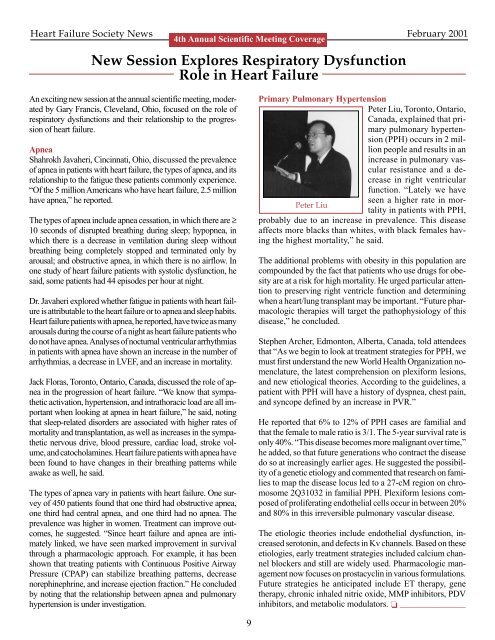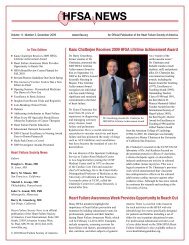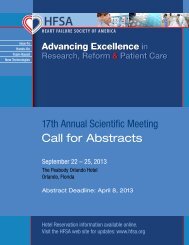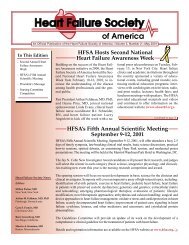Volume 3, Number 1 - Heart Failure Society of America
Volume 3, Number 1 - Heart Failure Society of America
Volume 3, Number 1 - Heart Failure Society of America
Create successful ePaper yourself
Turn your PDF publications into a flip-book with our unique Google optimized e-Paper software.
<strong>Heart</strong> <strong>Failure</strong> <strong>Society</strong> News February 2001<br />
4th Annual Scientific Meeting Coverage<br />
New Session Explores Respiratory Dysfunction<br />
Role in <strong>Heart</strong> <strong>Failure</strong><br />
An exciting new session at the annual scientific meeting, moderated<br />
by Gary Francis, Cleveland, Ohio, focused on the role <strong>of</strong><br />
respiratory dysfunctions and their relationship to the progression<br />
<strong>of</strong> heart failure.<br />
Apnea<br />
Shahrokh Javaheri, Cincinnati, Ohio, discussed the prevalence<br />
<strong>of</strong> apnea in patients with heart failure, the types <strong>of</strong> apnea, and its<br />
relationship to the fatigue these patients commonly experience.<br />
“Of the 5 million <strong>America</strong>ns who have heart failure, 2.5 million<br />
have apnea,” he reported.<br />
The types <strong>of</strong> apnea include apnea cessation, in which there are ≥<br />
10 seconds <strong>of</strong> disrupted breathing during sleep; hypopnea, in<br />
which there is a decrease in ventilation during sleep without<br />
breathing being completely stopped and terminated only by<br />
arousal; and obstructive apnea, in which there is no airflow. In<br />
one study <strong>of</strong> heart failure patients with systolic dysfunction, he<br />
said, some patients had 44 episodes per hour at night.<br />
Dr. Javaheri explored whether fatigue in patients with heart failure<br />
is attributable to the heart failure or to apnea and sleep habits.<br />
<strong>Heart</strong> failure patients with apnea, he reported, have twice as many<br />
arousals during the course <strong>of</strong> a night as heart failure patients who<br />
do not have apnea. Analyses <strong>of</strong> nocturnal ventricular arrhythmias<br />
in patients with apnea have shown an increase in the number <strong>of</strong><br />
arrhythmias, a decrease in LVEF, and an increase in mortality.<br />
Jack Floras, Toronto, Ontario, Canada, discussed the role <strong>of</strong> apnea<br />
in the progression <strong>of</strong> heart failure. “We know that sympathetic<br />
activation, hypertension, and intrathoracic load are all important<br />
when looking at apnea in heart failure,” he said, noting<br />
that sleep-related disorders are associated with higher rates <strong>of</strong><br />
mortality and transplantation, as well as increases in the sympathetic<br />
nervous drive, blood pressure, cardiac load, stroke volume,<br />
and catocholamines. <strong>Heart</strong> failure patients with apnea have<br />
been found to have changes in their breathing patterns while<br />
awake as well, he said.<br />
The types <strong>of</strong> apnea vary in patients with heart failure. One survey<br />
<strong>of</strong> 450 patients found that one third had obstructive apnea,<br />
one third had central apnea, and one third had no apnea. The<br />
prevalence was higher in women. Treatment can improve outcomes,<br />
he suggested. “Since heart failure and apnea are intimately<br />
linked, we have seen marked improvement in survival<br />
through a pharmacologic approach. For example, it has been<br />
shown that treating patients with Continuous Positive Airway<br />
Pressure (CPAP) can stabilize breathing patterns, decrease<br />
norephinephrine, and increase ejection fraction.” He concluded<br />
by noting that the relationship between apnea and pulmonary<br />
hypertension is under investigation.<br />
Primary Pulmonary Hypertension<br />
Peter Liu, Toronto, Ontario,<br />
Canada, explained that primary<br />
pulmonary hypertension<br />
(PPH) occurs in 2 million<br />
people and results in an<br />
increase in pulmonary vascular<br />
resistance and a decrease<br />
in right ventricular<br />
function. “Lately we have<br />
Peter Liu<br />
seen a higher rate in mortality<br />
in patients with PPH,<br />
probably due to an increase in prevalence. This disease<br />
affects more blacks than whites, with black females having<br />
the highest mortality,” he said.<br />
The additional problems with obesity in this population are<br />
compounded by the fact that patients who use drugs for obesity<br />
are at a risk for high mortality. He urged particular attention<br />
to preserving right ventricle function and determining<br />
when a heart/lung transplant may be important. “Future pharmacologic<br />
therapies will target the pathophysiology <strong>of</strong> this<br />
disease,” he concluded.<br />
Stephen Archer, Edmonton, Alberta, Canada, told attendees<br />
that “As we begin to look at treatment strategies for PPH, we<br />
must first understand the new World Health Organization nomenclature,<br />
the latest comprehension on plexiform lesions,<br />
and new etiological theories. According to the guidelines, a<br />
patient with PPH will have a history <strong>of</strong> dyspnea, chest pain,<br />
and syncope defined by an increase in PVR.”<br />
He reported that 6% to 12% <strong>of</strong> PPH cases are familial and<br />
that the female to male ratio is 3/1. The 5-year survival rate is<br />
only 40%. “This disease becomes more malignant over time,”<br />
he added, so that future generations who contract the disease<br />
do so at increasingly earlier ages. He suggested the possibility<br />
<strong>of</strong> a genetic etiology and commented that research on families<br />
to map the disease locus led to a 27-cM region on chromosome<br />
2Q31032 in familial PPH. Plexiform lesions composed<br />
<strong>of</strong> proliferating endothelial cells occur in between 20%<br />
and 80% in this irreversible pulmonary vascular disease.<br />
The etiologic theories include endothelial dysfunction, increased<br />
serotonin, and defects in Kv channels. Based on these<br />
etiologies, early treatment strategies included calcium channel<br />
blockers and still are widely used. Pharmacologic management<br />
now focuses on prostacyclin in various formulations.<br />
Future strategies he anticipated include ET therapy, gene<br />
therapy, chronic inhaled nitric oxide, MMP inhibitors, PDV<br />
inhibitors, and metabolic modulators. ❏ _______________<br />
9
















